For years Tim Dwyer has dreamed of running a downwind race from Point Judith to Jamestown, taking advantage of the prevailing south-easterly winds to hurtle us screaming across a 10+ mile span of open water. Since this route passes by the Beavertail Lighthouse that inspired the name of the Jamestown Double Beaver race, Tim decided to make the downwind run the official 2015 course (although the Beavertail would be little more than a blinking blur to competitors). Perhaps a quarter of the starters would never be seen again, but the survivors would be too jacked up on adrenalin to care very much.
The week before the race, Tim did a dry run of the proposed course. I was there too, but nobody told me about the “dry” part. Conditions for our trial were ideal – sustained winds of 15+ miles per hour out of the southeast with air temperature in the low 80s. Venturing into uncharted waters, Tim and I conservatively decided to use our most stable boats – a V8 and a V10 Sport, respectively. Like alpinists preparing to set a new climbing route on Everest, we carefully reviewed our safety equipment – leg leashes, phones, VHF radio, supplemental oxygen, flares, etc. The oxygen might not be strictly necessary at our elevation, but it’d come in handy for any below sea-level excursions. Finally, I strapped a GoPro on my head to record our historic first descent for posterity.
Launching into the calm waters of the Harbor of Refuge, we soon ventured past the breakwaters into unprotected seas. It wasn’t quite as rough as this year’s Blackburn, but it was plenty raucous. We had to cover a half-mile of beam and quartering waves to get clear of Point Judith itself before we could start our run. After accomplishing that rocky traverse, Tim stopped to point out the hazy purple protuberance on the northeast horizon that marked the southern tip of Jamestown, 7.5 miles downwind from us. Then, with a slightly unhinged twinkle in his eyes, he launched himself over the edge. We were off.
I won’t bore you with tales of our adventure – the break-neck speeds, the seamlessly linked runs, the thrill of catching oneself at the last moment before disaster (at least, I assume it would be thrilling), the bitter frustration at missing yet another runner that Tim managed to catch so easily (recording a top speed north of 13 mph in doing so). Suffice it to say that Dwyer’s Run lived up to its future billing as the premier New England downwind paddle. You’ll never have more fun while wearing neoprene shorts and a heart-rate monitor (I’m guessing). I couldn’t wait for everyone else to experience the downwind fun at this year’s Double Beaver.
Alas. As we now all know, Tim failed to submit the required paperwork before the deadline, and thus his application for favorable race-day winds was returned by those pencil-pushers at the Bureau with a gleefully red “DENIED” stamp. Through some back-channel maneuvering, well-placed bribes, and a dozen sacrificed chickens, however, Tim was able to secure a vague promise for northerly winds. This fallback option would allow the Double Beaver to be run as a downwind course along the length of Conanicut Island. We’d start at the north end of the island, round the House on the Rock at the south end, and finish upwind at the Yacht Club, 8.8 miles the wiser.
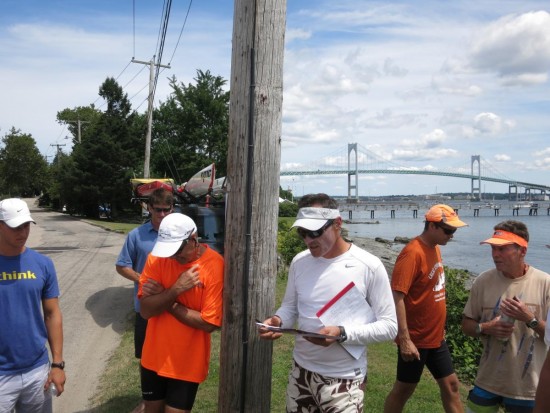
Somewhere around the third hour of his “History of Rhode Island” lecture, Tim started to lose the crowd.
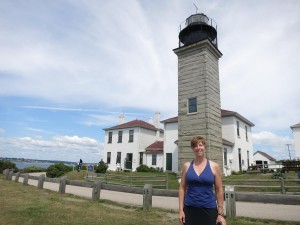 One unfortunate consequence of the course change was that we’d never even see the Beavertail Lighthouse. Muttering something about “brand continuity”, Tim petulantly refused to change the name of the race, even though I supplied him with some damned fine alternatives (like my personal favorite – the Jamestown Meager Beaver). Who knew what kind of karmic retribution this misrepresentation might call down on us? Just to be safe, Mary Beth and I arrived in Jamestown early enough for a pre-race pilgrimage to the lighthouse. Everyone else was on their own.
One unfortunate consequence of the course change was that we’d never even see the Beavertail Lighthouse. Muttering something about “brand continuity”, Tim petulantly refused to change the name of the race, even though I supplied him with some damned fine alternatives (like my personal favorite – the Jamestown Meager Beaver). Who knew what kind of karmic retribution this misrepresentation might call down on us? Just to be safe, Mary Beth and I arrived in Jamestown early enough for a pre-race pilgrimage to the lighthouse. Everyone else was on their own.
Twenty paddlers gathered at Bay Voyage Beach in Jamestown, nineteen of whom are required to consult with their doctors before attempting any strenuous activity. Among the grizzled regulars one fresh-faced youth stood out. This was up-and-coming flatwater specialist Jesse Lishchuk. As an international-caliber U23 paddler, Jesse could likely complete a 1000 meter sprint before the rest of us even finished taking our medication. In a 9 mile race in modest chop, however… maybe we’d managed to also get a few strokes in.
After a well-executed shuttle drop at the launch site, we gathered around to await the last-minute arrival of Jan Lupinski. As usual, he’d have been right on time had we been holding the race in, say, Denver. Once Jan had borrowed an entire paddling outfit from me (in an attempt to trick Mary Beth into cheering him on from shore), we mounted up and headed out to the starting line. The wind was northerly, but at a disappointing 8 mph wasn’t going to give us much to work with. I expect Tim probably mixed a few seagulls into his offering to save a buck or two. Studiously avoiding all eye contact, our conscience-stricken race director counted us down to a start.
Jesse jumped out to an early lead, taking a line away from shore. Jan, Andrius Zinkevichus, Eric Costanzo, Jim Hoffman and I followed in his rapidly dissipating wake, while Tim, Wesley, and Joe Shaw seemed to be holding closer to the island. Over the course of the next few miles, I managed to catch and overtake Andrius, Eric, Jim, and Jan (who, in a moment of supreme confusion, I momentarily mistook for myself before the smooth stroke gave me… I mean him… away). Jesse extended his lead during this time, but didn’t seem to be running away from us.
Although we started the race shortly before high tide, the currents within Narragansett Bay are notoriously difficult to predict. I perhaps should have figured out that I was on a suboptimal line when, two miles into the race, I glanced over to see someone – let’s call him Paddler X to preserve his anonymity – near the shore keeping pace with me. I don’t mean to cast aspersions on him (despite his pretentious moniker), but experience has indicated that by this stage in a race I should be safely ahead of him. How could Paddler X still be in the hunt? And yet there he was in his V10 with those dumb Toy Story figurines. Oops. I may have blown your cover, X.
In retrospect, it seems that paddlers closer to shore were escaping the tidal current that I was paddling against out in the channel. I’ve found that obliviousness is much closer to bliss than ignorance. Sprinkle a little knowledge on ignorance, next thing you know you’re shrouding your loins with fig leaves and looking for a new home. Obliviousness, on the other hand, can shed a torrent of facts and explanations without the least dampening of spirit. Ample evidence that I was needlessly working against the tidal current? I reject the very concept of evidence! I chose to achieve inner peace through the path of obliviousness. Which just happened to coincide almost perfectly with that of the channel.
Fortunately, many of those smarty-pants paddlers who tried to game the system ran into problems later, when the confused currents of the Bay thwarted their best efforts to divine the transcendent path. I also heard reports that the inner line was rife with floating biological contaminants. Perplexed by his uncharacteristically slow pace, Tim Hudyncia leapt overboard to inspect his undercarriage. His official report indicated that he had “significant accumulations of organic material” on his rudder. Cleaning off the weeds seemed to restore his speed, but Tim’s also taking a full course of amoxicillin – just to be sure.
In the mean time, let’s see if we can finally keep the Nahant Bay Cup in New England.
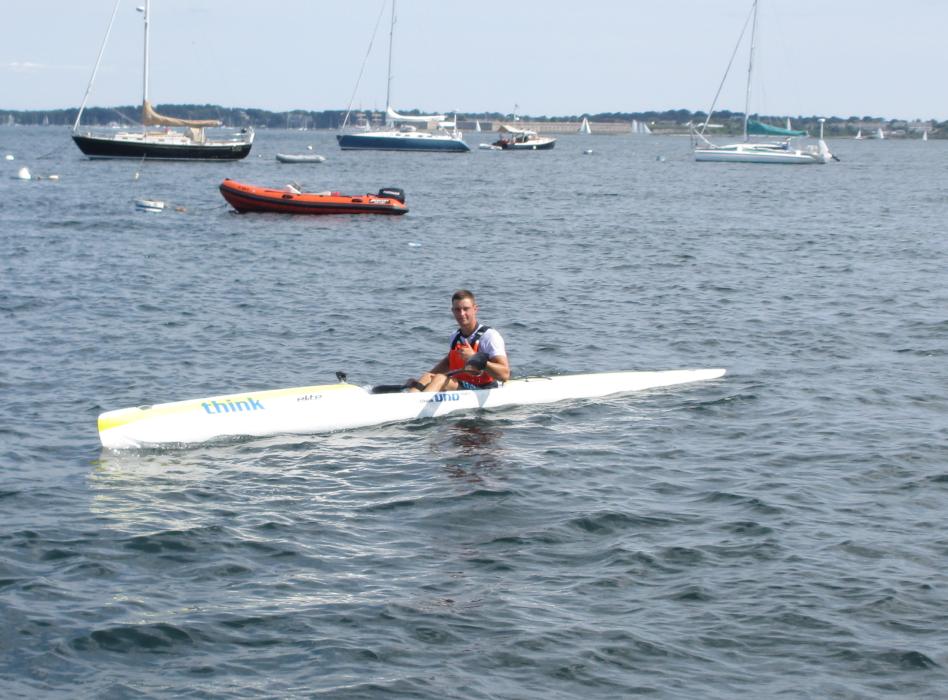
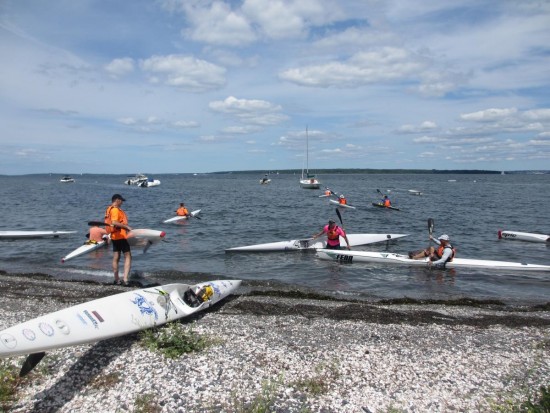
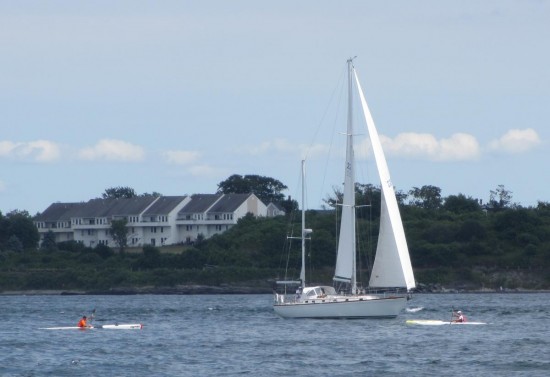
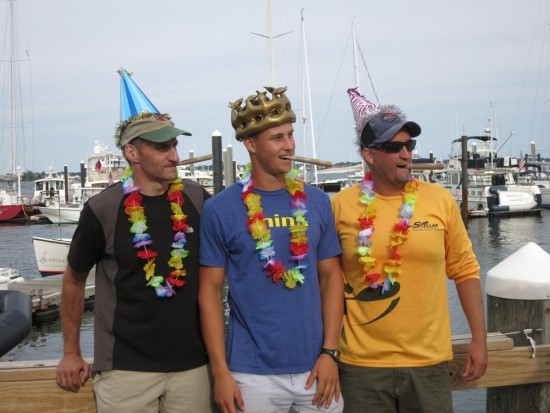
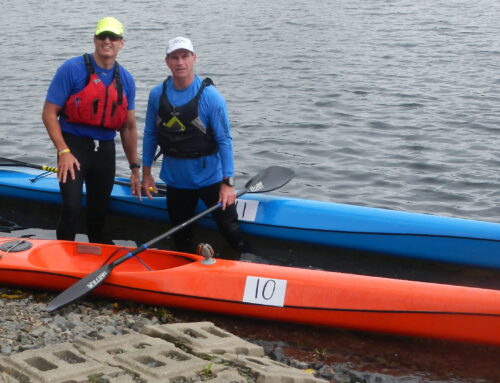
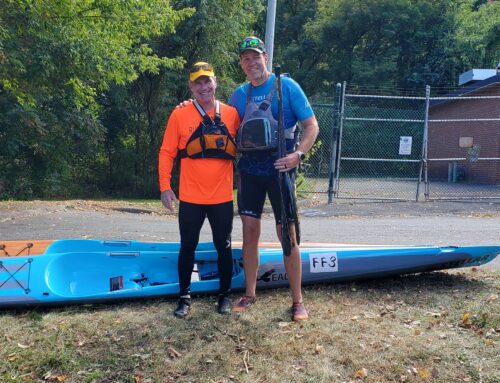
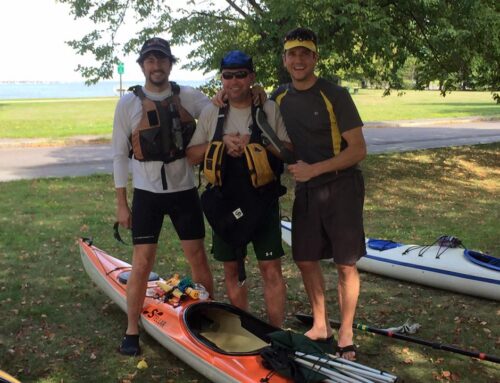
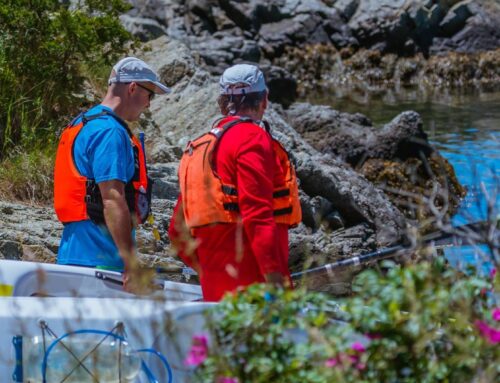
Leave A Comment
You must be logged in to post a comment.